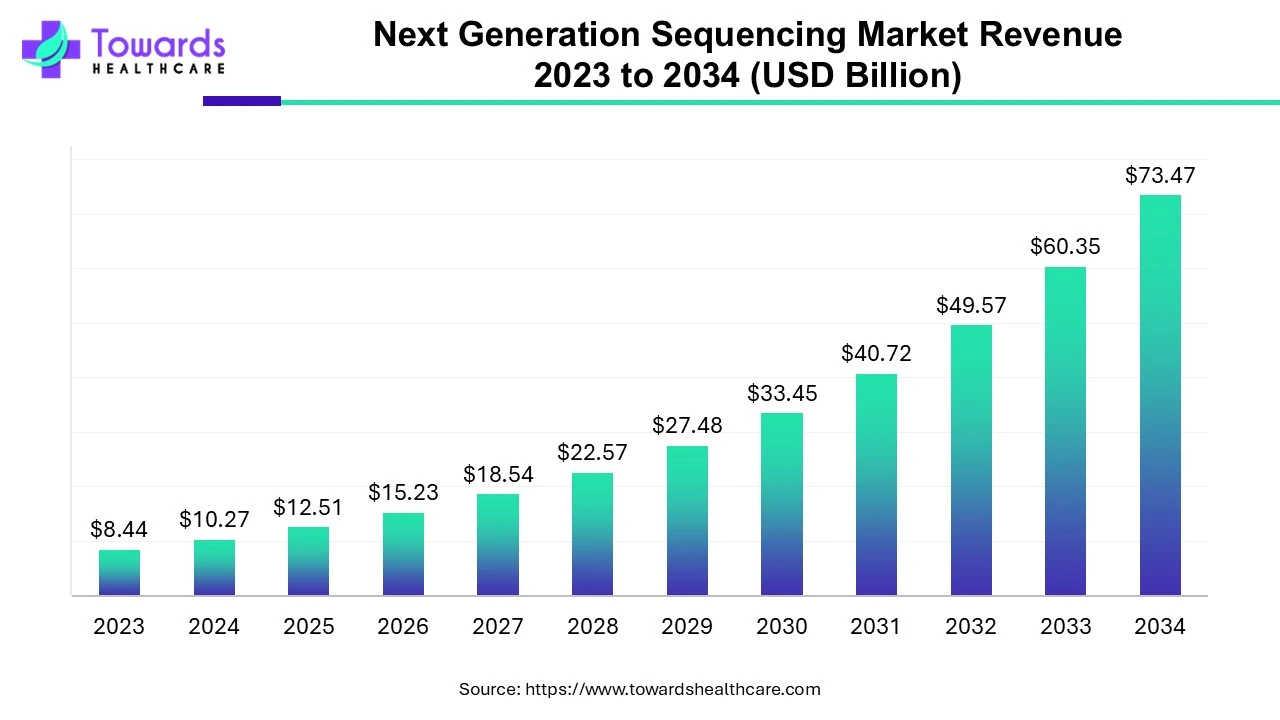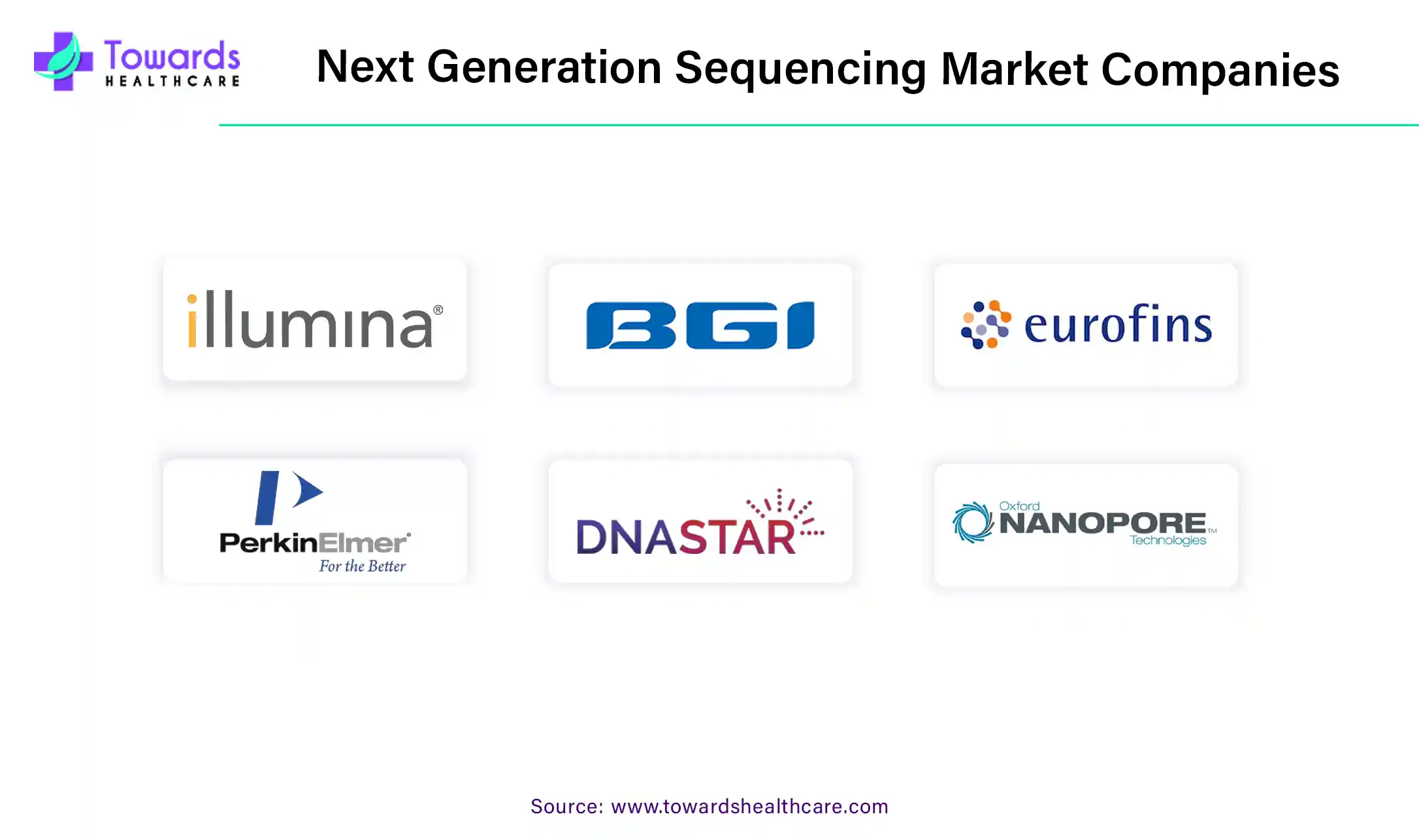March 2025


Principal Consultant

Reviewed By
The global next generation sequencing market size is calculated at US$ 10.27 billion in 2024, grew to US$ 12.51 billion in 2025, and is projected to reach around US$ 73.47 billion by 2034. The market is expanding at a CAGR of 21.74% between 2024 and 2034. The NGS market is strongly growing because NGS is needed in disease diagnosis, disease analysis, developing new treatment options, developing gene & cell therapies, etc.

The next generation sequencing market deals with products, services, and devices needed for sequencing of genetic materials. The market also encompasses research and development associated with next generation sequencing (NGS). The technique known as next-generation sequencing (NGS) is used to identify the DNA or RNA sequence in order to investigate genetic variation linked to illnesses or other biological phenomena. The biological sciences have undergone a revolution thanks to it, as labs are now able to investigate biological systems and carry out a wide range of applications. Traditional DNA sequencing technologies are unable to provide the depth of information required to answer today's complicated genomics issues. That vacuum has been filled by NGS, which is now a common tool for answering these queries.
The healthcare system is evolving as a result of the widespread application of artificial intelligence (AI), especially deep learning, in many biological contexts today. In NGS-based diagnostics, artificial intelligence (AI) has shown encouraging potential in improving variant calling accuracy, improving variant prediction, and making electronic health record (EHR) systems more user-friendly.
For instance,
Applications in Disease Diagnosis: Hundreds of thousands of genes or entire genomes can be sequenced quickly with NGS. Patient follow-up, prognosis, diagnosis, and treatment decisions have all made extensive use of the sequence variations and mutations found by NGS. Its enormous parallel sequencing capacity opens up new possibilities for precision treatment that is tailored to each patient.
Ethical Challenges: There are aspects of using NGS in clinical and research settings that make it difficult to uphold established ethical standards for safeguarding patients and research participants. NGS produces vast volumes of data and findings with varying levels of established clinical significance. The right procedures for data management, communication, and protection must be decided.
Diagnosis and Treatment of Rare Diseases: Roughly 30 million Europeans, 25–50 million Americans, and 8% of Australians suffer from a rare disease. Because it is difficult to get a precise diagnosis, rare diseases are a major challenge for physicians and contribute to the high expenditures of healthcare around the world. The wide phenotypic spectrum of most genes, the significance of mosaic and de novo mutations, the affordability and speed of genetic diagnosis, the detection of digenic inheritance or the presence of multiple rare diseases in a single patient, and the development of promising new treatments have all been made possible by NGS.
By technology, the target sequencing & resequencing segment dominated the next generation sequencing market in 2023. Researchers can concentrate their effort, resources, and data analysis on certain areas of interest by employing targeted techniques with NGS. Additionally, targeted techniques can provide significantly better coverage levels, making it possible to identify variations that whole-genome or Sanger sequencing cannot detect since they are rare and more costly.
For instance,
By product, the consumables segment held the largest share of the next generation sequencing market in 2023 and is expected to grow at the fastest rate during the forecast period. Consumables include kits, reagents, chemicals, enzymes, buffers, solutions, catalysts, and other formulations needed for genetic sequencing. With growing applications of NGS, the demand for consumables is also estimated to grow significantly in the future.
By application, the oncology segment held the major share of the next generation sequencing market in 2023. According to projections from the Global Cancer Observatory (GLOBOCAN), 19.3 million incident cases of cancer occurred globally in 2020. It is predicted that the number of cancer cases will rise by 12.8% in 2025 compared to 2020. NGS is used to bulk-sequence tumors and find genetic alterations in tumors, which helps with targeted therapy development and liquid biopsies to track the progression of cancer.
By application, the consumer genomics segment is expected to grow at the fastest rate in the next generation sequencing market during the predicted timeframe. With over 10 million customers now genotyped, the consumer genomics market is developing and gaining traction. Finally, the general public is being exposed to new uses and developments, some of which were unexpected.
By workflow, the sequencing segment was dominant in the next generation sequencing market in 2023. It is anticipated that the information included in DSVs will retool clinicians through medical DNA sequencing. DSVs with high effect sizes are probably going to be useful in preclinical and early diagnosis, prognostication, and therapeutic customization.
By workflow, the NGS data analysis segment is anticipated to grow as the fastest rate in the next generation sequencing market during 2024-2034. Because Next Generation Sequencing (NGS) technologies are producing previously unheard-of volumes of data in the domains of genomes, transcriptomics, and epigenomics, they have completely transformed bioscience, biotechnology, and medicine. Nevertheless, in order to obtain valuable insights and make practical deductions, the data produced by NGS technologies must be thoroughly examined.
By end-use, the academic research segment dominated the next generation sequencing market in 2023. Sequencing technologies are quickly making their way into clinical care and are currently being utilized in research settings. Whole genome sequencing is currently being investigated in trials to determine future dangers and suitable treatments for both healthy and ill populations.
By end-use, the clinical research segment is estimated to grow rapidly in the next generation sequencing market during the forecast period. Clinical research helps us better grasp the role that genes play in the development of certain diseases. Researchers at NHGRI are collaborating with patients and families who have a history of hereditary diseases in order to better understand the genetic components of both common and uncommon disorders and to create new, more efficient diagnostic and therapeutic approaches.
North America held the largest next generation sequencing market share in 2023. The region's broad use of next-generation sequencing technologies is a result of several reasons. These include government support for genomics research, a well-established healthcare system, and the rising incidence of chronic illnesses. The next-generation sequencing market in the region is expected to increase due to the presence of major market participants and easy access to cutting-edge genomic research technology.
Furthermore, thanks to developments in genetic research, falling sequencing technology costs, and the growing use of NGS in personalized medicine, the United States led the North American market in 2023. NGS is transforming diagnostics by offering thorough insights into genetic variants and mutations. This is especially true in oncology, where it makes exact tumor profiling and tailored therapy possible. The market forecast for next-generation sequencing is also being bolstered by the increase in research efforts pertaining to pharmacogenomics, infectious diseases, and genetic disorders.
For instance,
Asia Pacific is expected to grow at the fastest rate during the forecast period. Because next-generation sequencing is becoming more and more advanced and cheaper, the number of cancer cases is rising, and next-generation sequencing is being used more and more in cancer research. The next generation technology has been adopted by emerging economies like China, Japan, and India since it is less expensive. Advances in genomics and the creation of various sequencing techniques and tactics have contributed to the decline in sequencing costs in India over time. In addition, India's generation market grew at the fastest rate in the Asia-Pacific area, while China's generation market held the greatest next generation sequencing market share.
In addition to facing public health challenges, including HIV/AIDS, malaria, TB, and other infectious diseases, India is poised to become the third-largest economy in the world by 2030. In India, one in nine people is expected to get cancer in their lifetime, and up to 96 million people are thought to have a rare disease1. Increasing genomics access in India will contribute to the development of health care and the fight against climate change.

By Technology
By Product
By Application
By Workflow
By End-use
By Region
March 2025
December 2024
December 2024
November 2024